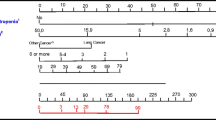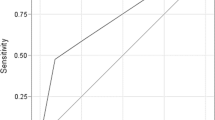Abstract
Background
The objective of this study was to develop and validate a new prognostic model for febrile neutropenia (FN).
Methods
This study comprised 1001 episodes of FN: 718 for the derivation set and 283 for the validation set. Multivariate logistic regression analysis was performed with unfavorable outcome as the primary endpoint and bacteremia as the secondary endpoint.
Results
In the derivation set, risk factors for adverse outcomes comprised age ≥60 years (2 points), procalcitonin ≥0.5 ng/mL (5 points), ECOG performance score ≥2 (2 points), oral mucositis grade ≥3 (3 points), systolic blood pressure <90 mmHg (3 points), and respiratory rate ≥24 breaths/min (3 points). The model stratified patients into three severity classes, with adverse event rates of 6.0 % in class I (score ≤2), 27.3 % in class II (score 3–8), and 67.9 % in class III (score ≥9). Bacteremia was present in 1.1, 11.5, and 29.8 % of patients in class I, II, and III, respectively. The outcomes of the validation set were similar in each risk class. When the derivation and validation sets were integrated, unfavorable outcomes occurred in 5.9 % of the low-risk group classified by the new prognostic model and in 12.2 % classified by the Multinational Association for Supportive Care in Cancer (MASCC) risk index.
Conclusions
With the new prognostic model, we can classify patients with FN into three classes of increasing adverse outcomes and bacteremia. Early discharge would be possible for class I patients, short-term observation could safely manage class II patients, and inpatient admission is warranted for class III patients.

Similar content being viewed by others
References
Klastersky J, Paesmans M, Rubenstein EB et al (2000) The multinational association for supportive care in cancer risk index: a multinational scoring system for identifying low-risk febrile neutropenic cancer patients. J Clin Oncol 18(16):3038–3051
Baskaran ND, Gan GG, Adeeba K (2008) Applying the multinational association for supportive care in cancer risk scoring in predicting outcome of febrile neutropenia patients in a cohort of patients. Ann Hematol 87(7):563–569. doi:10.1007/s00277-008-0487-7
Innes H, Lim SL, Hall A et al (2008) Management of febrile neutropenia in solid tumours and lymphomas using the Multinational Association for Supportive Care in Cancer (MASCC) risk index: feasibility and safety in routine clinical practice. Support Care Cancer 16(5):485–491. doi:10.1007/s00520-007-0334-8
Talcott JA, Siegel RD, Finberg R et al (1992) Risk assessment in cancer patients with fever and neutropenia: a prospective, two-center validation of a prediction rule. J Clin Oncol 10(2):316–322
de Naurois J, Novitzky-Basso I, Gill MJ et al (2010) Management of febrile neutropenia: ESMO clinical practice guidelines. Ann Oncol 21(Suppl 5):v252–v256. doi:10.1093/annonc/mdq196
Freifeld AG, Bow EJ, Sepkowitz KA et al (2011) Clinical practice guideline for the use of antimicrobial agents in neutropenic patients with cancer: 2010 update by the Infectious Diseases Society of America. Clin Infect Dis 52(4):e56–e93. doi:10.1093/cid/cir073
Worth LJ, Lingaratnam S, Taylor A et al (2011) Use of risk stratification to guide ambulatory management of neutropenic fever. Australian Consensus Guidelines 2011 Steering Committee. Intern Med J 41(1b):82–89. doi:10.1111/j.1445-5994.2010.02339.x
Engel A, Steinbach G, Kern P et al (1999) Diagnostic value of procalcitonin serum levels in neutropenic patients with fever: comparison with interleukin-8. Scand J Infect Dis 31(2):185–189
Giamarellos-Bourboulis EJ, Grecka P, Poulakou G et al (2001) Assessment of procalcitonin as a diagnostic marker of underlying infection in patients with febrile neutropenia. Clin Infect Dis 32(12):1718–1725. doi:10.1086/320744
Hambach L, Eder M, Dammann E et al (2002) Diagnostic value of procalcitonin serum levels in comparison with C-reactive protein in allogeneic stem cell transplantation. Haematologica 87(6):643–651
Persson L, Engervall P, Magnuson A et al (2004) Use of inflammatory markers for early detection of bacteraemia in patients with febrile neutropenia. Scand J Infect Dis 36(5):365–371
Fraunberger P, Wang Y, Holler E et al (2006) Prognostic value of interleukin 6, procalcitonin, and C-reactive protein levels in intensive care unit patients during first increase of fever. Shock 26(1):10–12. doi:10.1097/01.shk.0000215319.06866.bd
Sakr Y, Sponholz C, Tuche F et al (2008) The role of procalcitonin in febrile neutropenic patients: review of the literature. Infection 36(5):396–407. doi:10.1007/s15010-008-7374-y
Lee DG, Kim SH, Kim SY et al (2011) Evidence-based guidelines for empirical therapy of neutropenic fever in Korea. Korean J Intern Med 26(2):220–252. doi:10.3904/kjim.2011.26.2.220
Sullivan LM, Massaro JM, D’Agostino RB Sr (2004) Presentation of multivariate data for clinical use: the Framingham study risk score functions. Stat Med 23(10):1631–1660. doi:10.1002/sim.1742
Uys A, Rapoport BL, Anderson R (2004) Febrile neutropenia: a prospective study to validate the Multinational Association of Supportive Care of Cancer (MASCC) risk-index score. Support Care Cancer 12(8):555–560. doi:10.1007/s00520-004-0614-5
Uys A, Rapoport BL, Fickl H et al (2007) Prediction of outcome in cancer patients with febrile neutropenia: comparison of the Multinational Association of Supportive Care of Cancer risk-index score with procalcitonin, C-reactive protein, serum amyloid A, and interleukins-1beta, -6, -8 and -10. Eur J Cancer Care (Engl) 16(6):475–483. doi:10.1111/j.1365-2354.2007.00780.x
Klastersky J, Paesmans M, Georgala A et al (2006) Outpatient oral antibiotics for febrile neutropenic cancer patients using a score predictive for complications. J Clin Oncol 24(25):4129–4134. doi:10.1200/JCO.2005.03.9909
Klastersky J, Paesmans M (2013) The Multinational Association for Supportive Care in Cancer (MASCC) risk index score: 10 years of use for identifying low-risk febrile neutropenic cancer patients. Support Care Cancer 21(5):1487–1495. doi:10.1007/s00520-013-1758-y
Ruokonen E, Nousiainen T, Pulkki K et al (1999) Procalcitonin concentrations in patients with neutropenic fever. Eur J Clin Microbiol Infect Dis 18(4):283–285
Ahn S, Lee YS (2012) Predictive factors for poor prognosis febrile neutropenia. Curr Opin Oncol 24(4):376–380. doi:10.1097/CCO.0b013e328352ead2
Carmona-Bayonas A, Gomez J, Gonzalez-Billalabeitia E et al (2011) Prognostic evaluation of febrile neutropenia in apparently stable adult cancer patients. Br J Cancer 105(5):612–617. doi:10.1038/bjc.2011.284
Escalante CP, Weiser MA, Manzullo E et al (2004) Outcomes of treatment pathways in outpatient treatment of low risk febrile neutropenic cancer patients. Support Care Cancer 12(9):657–662. doi:10.1007/s00520-004-0613-6
Hodgetts TJ, Kenward G, Vlachonikolis IG et al (2002) The identification of risk factors for cardiac arrest and formulation of activation criteria to alert a medical emergency team. Resuscitation 54(2):125–131
Subbe CP, Kruger M, Rutherford P et al (2001) Validation of a modified early warning score in medical admissions. QJM 94(10):521–526
Conflict of interest
YSL received a research grant from from Asan Institute for Life Science, Asan Medical Center, Republic of Korea (No. AILS10-498); SA, JLL, KSL, and SCY have no conflict of interest.
Author information
Authors and Affiliations
Corresponding author
Electronic supplementary material
Below is the link to the electronic supplementary material.
About this article
Cite this article
Ahn, S., Lee, YS., Lee, JL. et al. A new prognostic model for chemotherapy-induced febrile neutropenia. Int J Clin Oncol 21, 46–52 (2016). https://doi.org/10.1007/s10147-015-0853-0
Received:
Accepted:
Published:
Issue Date:
DOI: https://doi.org/10.1007/s10147-015-0853-0




